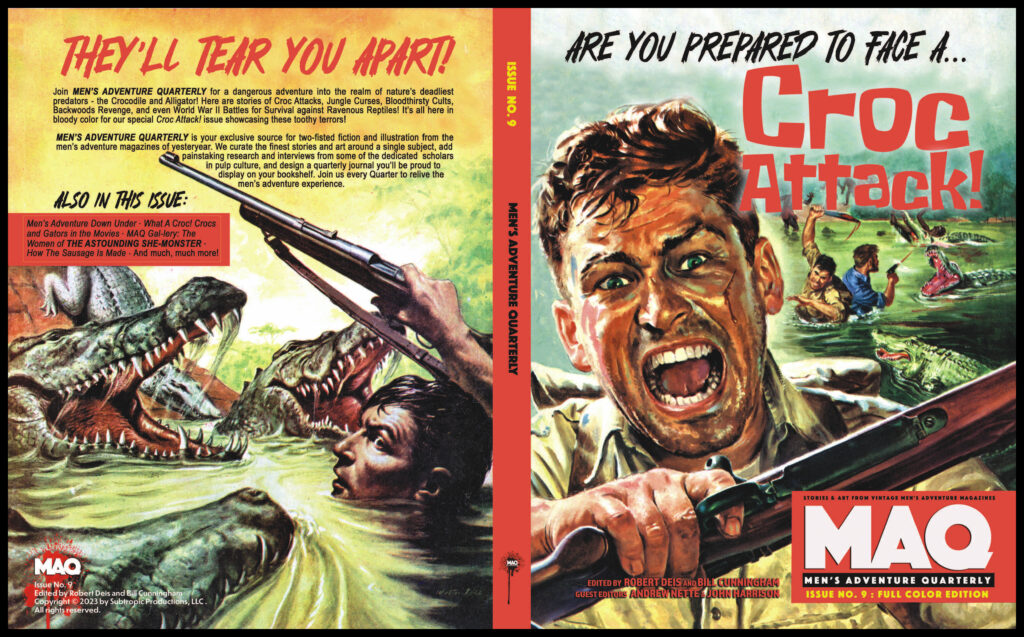
Issue #9 of the MEN’S ADVENTURE QUARTERLY is a cornucopia of classic men’s adventure magazine stories and artwork that feature crocodile and alligator attacks. It also includes: a special exclusive article about killer croc and gator movies by movie maven John Harrison; the first ever article providing an overview about Australian MAMs written by pulp culture historian and novelist Andrew Nette (I’ll talk more about those in a second post about MAQ #9); our usual “Gal-Lery” feature showcasing some beautiful ladies; lots of vintage ads and cartoons; and, much more.
Many MAM “killer creature” yarns involve critters that don’t pose a real threat to people. But crocs and gators are among the few big animals that can and do kill a fair number of humans every year. Of course, man is still the biggest killer of humans and every other species on the planet. Fear of some “maneaters,” like sharks and bears, is way out of sync with the handful of people they kill annually.
The incidence of human deaths caused by members of the Crocodylidae family, which includes true crocodiles, alligators and caimans, is a bit more impressive. Indeed, big crocodiles kill about 1,000 people in Africa alone each year. Crocs do kill some people in other places outside of Africa, but not many. Even in Australia, only a few people die from croc attacks each year and it’s big news when it happens.
In Florida, where I live, our relatively small freshwater crocs are an endangered species, mostly known for trying to grab a pet dog now and then. Dozens of people are bitten by alligators here annually, but only about five or six are fatal attacks. A few deaths by gator also occur in other U.S. states each year, like South Carolina, Louisiana and Texas.
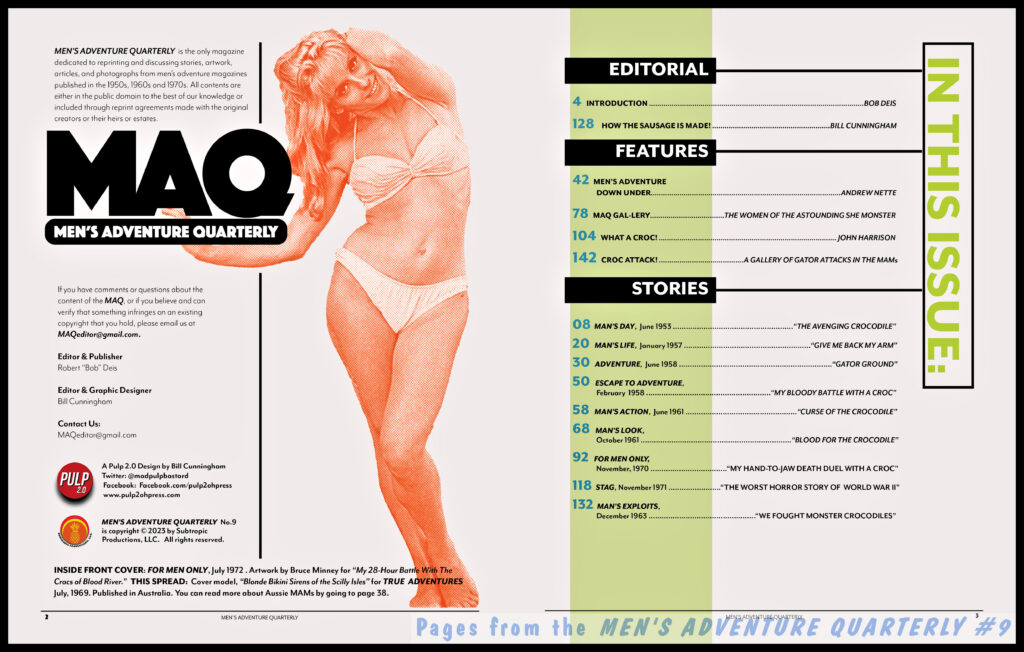
Of course, while your odds of being attacked and killed by a either croc or gator are low, the idea of it—like the idea of being attacked and killed by a shark—is scary as hell. And, like sharks, killer crocs and gators are good subjects for stories like those reprinted in MAQ #9, for novels, and for movies.
The first story— “The Avenging Crocodile” from MAN’S DAY, June 1953—was penned by a writer who, though highly prolific and once fairly well known, is now almost totally forgotten. His pen name was Brian O’Brien. His full birth name was Albert Hayward Young-O’Brien.
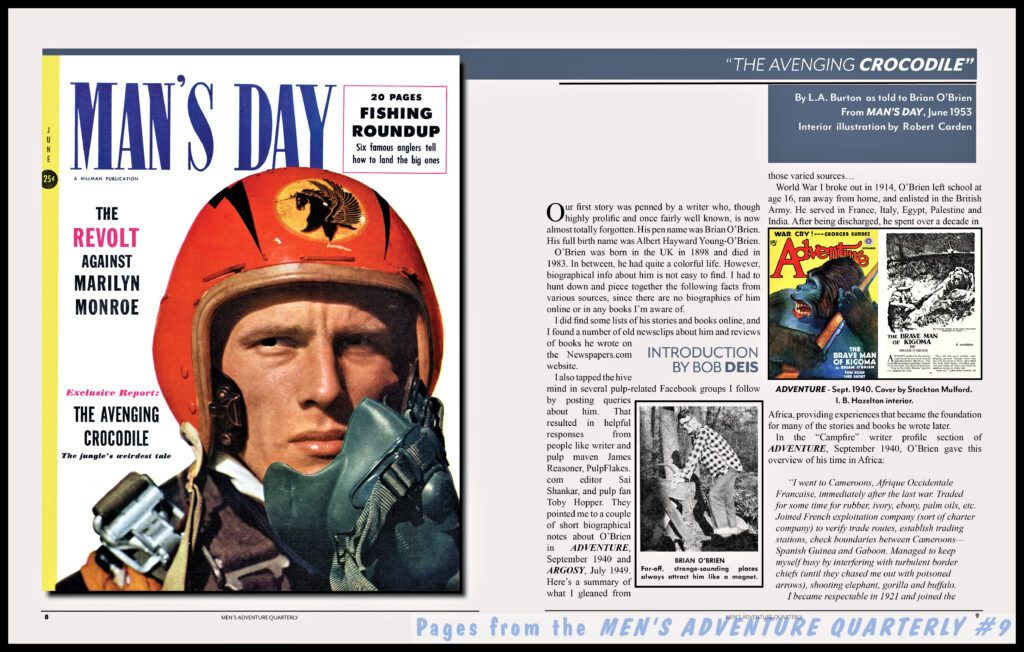
O’Brien was born in the UK in 1898 and died in 1983. In between, he had quite a colorful life. When World War I broke out in 1914, O’Brien left school at age 16, ran away from home, and enlisted in the British Army. He served in France, Italy, Egypt, Palestine and India. After being discharged, he spent over a decade in Africa, providing experiences that became the foundation for many of the stories and books he wrote later.
From the mid-1930s to the mid-1950s, he wrote scores of action/adventure stories for pulp magazines. In the ‘50s and ‘60s, O’Brien wrote adventure and history stories for men’s adventure mags. He also wrote articles for a number of mainstream magazines and at least five books based on his African adventures.
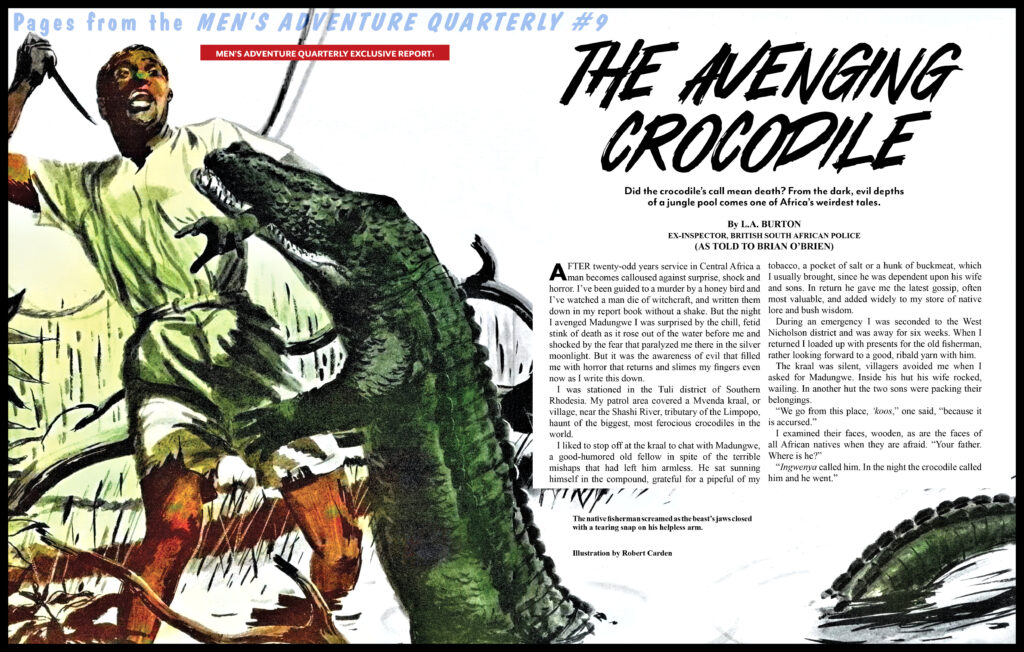
One of the odd things I found out about O’Brien from a search in Newspapers,com is that he was popular enough to get an endorsement deal with Ballantine Ale. In 1952, he was featured in a nicely illustrated print ad for Ballantine that appeared in newspapers around the country. It describes O’Brien as a “roving foreign correspondent and free-lance writer, who knows Africa and the Middle East as few other men do.”
O’Brien was still writing stories that appeared in MAMs in the mid-1960s. He died in 1983 at age 85. I don’t know what he was up to during his final two decades. But somehow, I can’t believe he just sat around in a rocking chair, getting buzzed on Ballantine Ale.
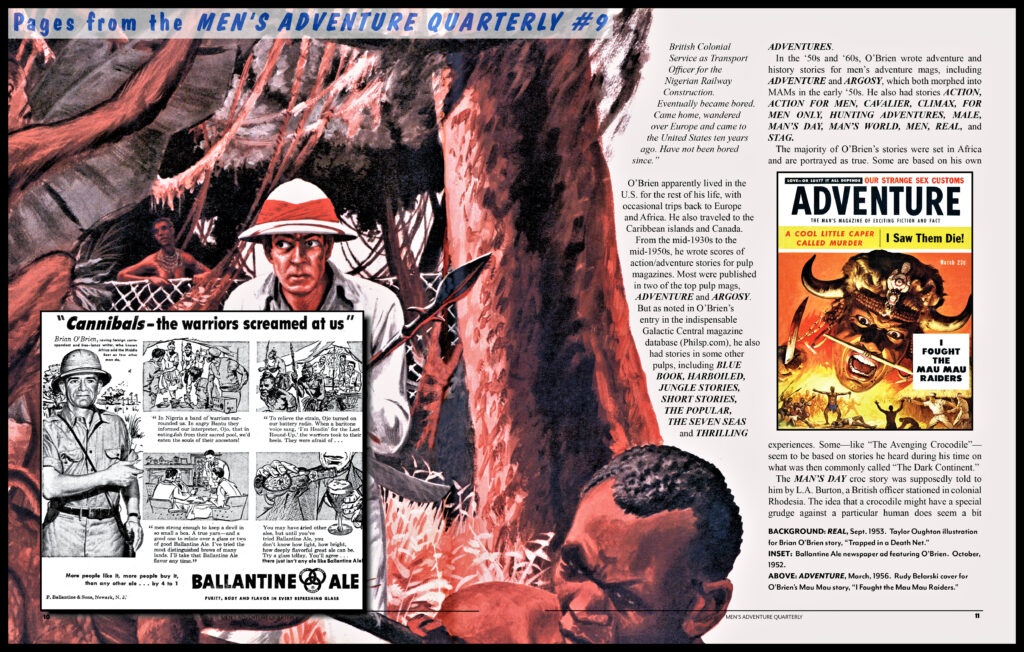
The next wild story, “Give Me Back My Arm,” comes from MAN’S LIFE, January 1957. MAN’S LIFE often featured killer critter stories. It also featured some of the best MAM artwork in that subgenre. Indeed, that venerable mag gave us the most famous killer critter cover of all: the September 1956 issue, featuring the classic “Weasels Ripped My Flesh” painting by artist Wilbur “Wil” Hulsey. That’s the one that inspired me to collect MAMs and led me to launch the Men’s Adventure Library book series with Wyatt Doyle, which began with the anthology we titled WEASELS RIPPED MY FLESH! (Yes, that story is in the book.)
Hulsey did more than two dozen other animal attack covers for MAN’S LIFE and another Crestwood Publishing MAM, TRUE MEN STORIES. The alligator cover painting for the MAN’S LIFE issue “Give Me Back My Arm” appeared in is one of many classic Hulseys.
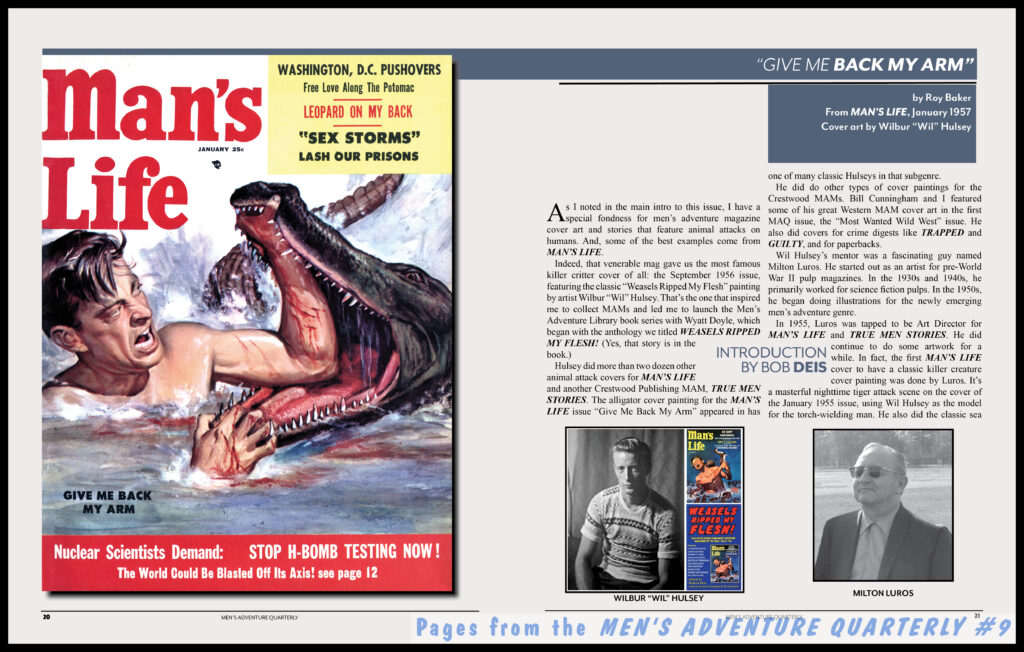
He did do other types of cover paintings for the Crestwood MAMs. Bill Cunningham and I featured some of his great Western MAM cover art in the first MAQ issue, the “Most Wanted Wild West” issue. He also did covers for crime digests like TRAPPED and GUILTY, and for paperbacks.
Wil Hulsey’s mentor was a fascinating guy named Milton Luros. He started out as an artist for pre-World War II pulp magazines. In the 1930s and 1940s, he primarily worked for science fiction pulps. In the 1950s, he began doing illustrations for the newly emerging men’s adventure genre.
In 1955, Luros was tapped to be Art Director for MAN’S LIFE and TRUE MEN STORIES. He did continue to do some artwork for a while. In 1955, he also created the American Art Agency and became a representative for other artists, including Wil Hulsey and Norman Saunders.
In 1958, he launched his own magazine enterprise under the banners of several companies he created, including American Art Archives and Parliament News. He brought Wil Husley to California to serve as his Art Director. The Milton Luros men’s mags included COCKTAIL, JAYBIRD, MIDNIGHT, NYLON PARTY, and other “under the counter” classics primarily sold at liquor stores and tobacco shops. Luros also began publishing sleaze paperbacks. By the mid-1960s he had created one of America’s biggest porn empires.
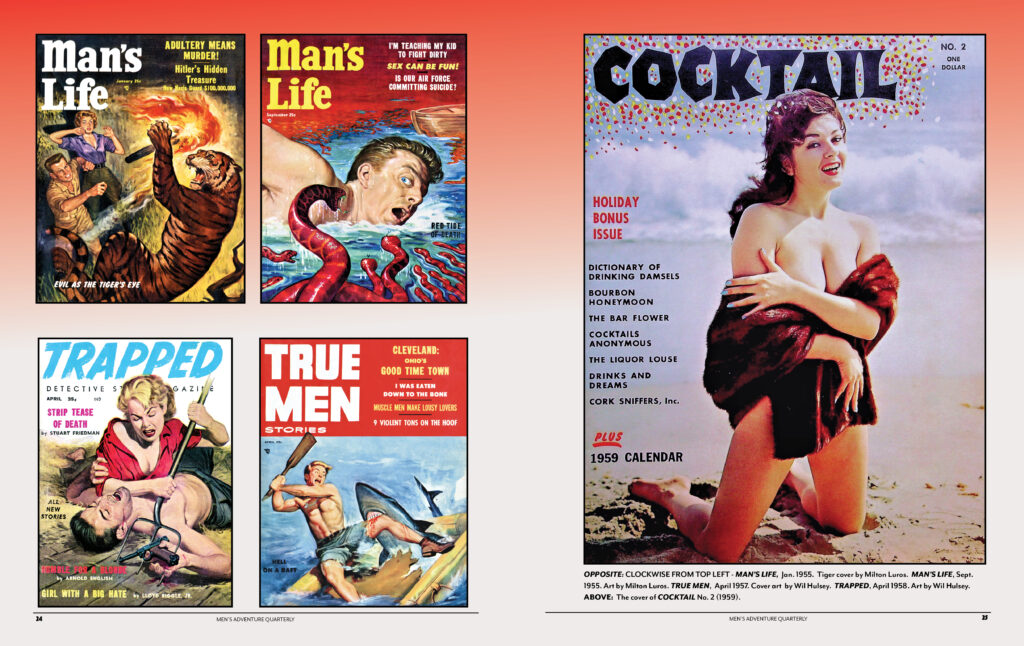
The next story, “Gator Ground,” comes from ADVENTURE, June 1958. The cover of that issue was painted by the great Mort Künstler. The Interior illustration was done by Doug Allen. The cover painting is a Civil War scene created years before Mort became especially well known for his Civil War art,. In fact, many of Mort’s fans primarily know him for the Civil War paintings he focused on doing for art galleries and books, starting in the 1980s. Few of them know that he did his first Civil War art for men’s adventure magazines in the 1950s and 1960s.
When Wyatt Doyle and I interviewed Mort for the book MORT KÜNSTLER: THE GODFATHER OF PULP FICTION ILLUSTRATORS, which showcases over 100 of the original paintings he did for men’s adventure mags, he told us: “There’s no way I could have done what I did later if I hadn’t had all that men’s adventure magazine work”
Most of Mort’s MAM artwork was done for the Goodman MAMs, such as FOR MEN ONLY, MALE, MEN, STAG, and MAN’S WORLD. He also did cover and interior artwork for MAMs put out by other major publishers, including ADVENTURE, SAGA, and TRUE, as well as for outdoor sports magazines, like OUTDOOR LIFE. But it was the Goodman MAMs that helped prepare him for the next phase of his career.

The artist who did the interior illustration for the story “Gator Ground,” Doug Allen (b. 1935), is another top illustration artist who started out working for magazines, including MAMs, outdoor sports mags, and mainstream periodicals. As the market for magazine art dwindled, Allen focused on doing paintings of animals for galleries and books. He became widely recognized as one of America’s foremost wildlife artists. He’s one of the artists featured at the National Museum of Wildlife Art in Wyoming.
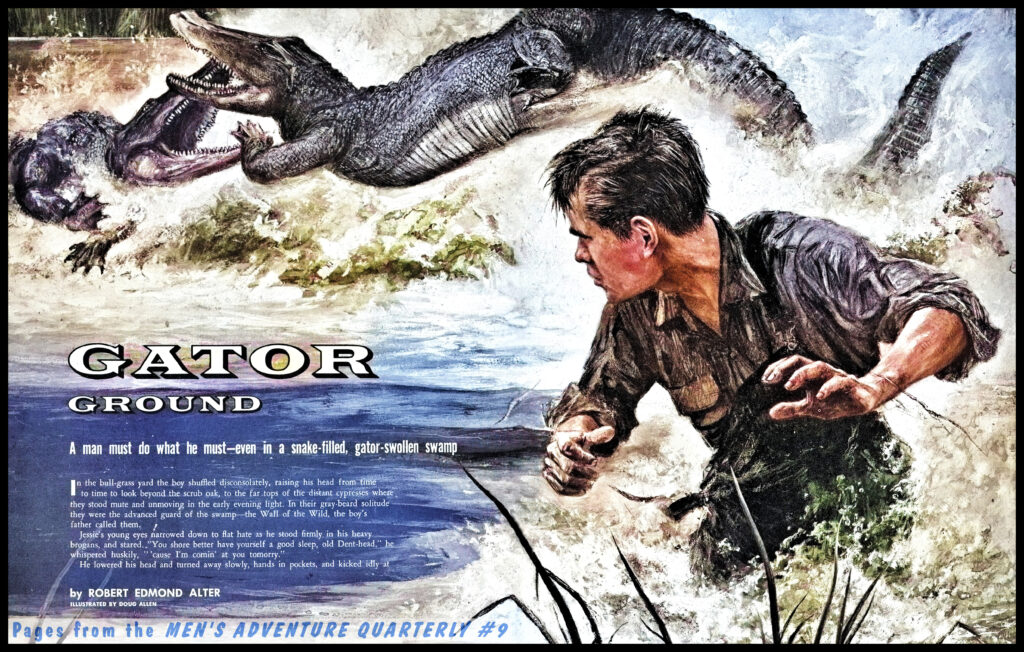
“Gator Ground” was penned by Robert Edmond Alter, a talented writer who probably would have become famous if he hadn’t died from cancer at age 40 in 1966. In the decade before that, he wrote scores of short stories for mystery and crime digest magazines like ALFRED HITCHCOCK’S MYSTERY MAGAZINE, MANHUNT and THE MIKE SHAYNE MYSTERY MAGAZINE. He also wrote some great stories for top MAMs, like ADVENTURE and ARGOSY. In addition, he wrote three novels that have become cult classics—CARNY KILL, SWAMP SISTER and PATH TO SAVAGERY, which was adapted into the 1979 movie RAVAGERS, starring Richard Harris, Ernest Borgnine, and Ann Turkel.
The guy this story is credited to, alleged “gator hunter” Bill Gentry, did not exist. As is the case with many men’s adventure magazine stories, that’s a pseudonym for some unknown writer. The amazingly cool cover painting that goes with the story, titled “My Bloody Battle with a Croc,” was done by Doug Rosa, full name William Douglas Rosa. Sadly, he died at age 44 in 1976, before he managed to achieve widespread fame.
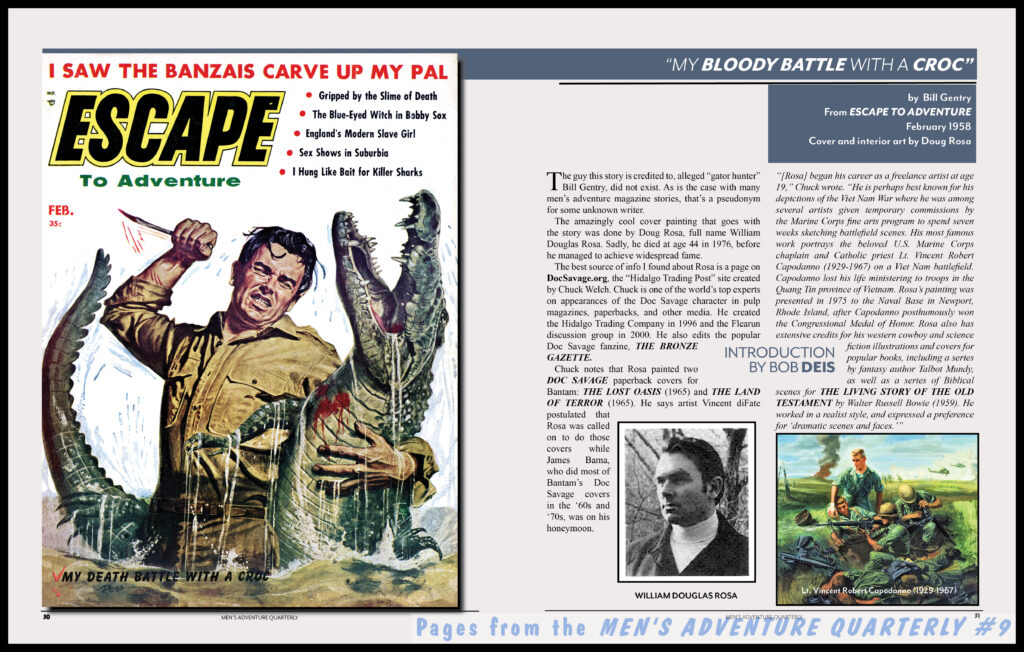
The best source of info I found about Rosa is a page on DocSavage.org, the “Hidalgo Trading Post” site created by Chuck Welch. Chuck is one of the world’s top experts on appearances of the Doc Savage character in pulp magazines, paperbacks, and other media. He created the Hidalgo Trading Company in 1996 and the Flearun discussion group in 2000. He also edits the popular Doc Savage fanzine, THE BRONZE GAZETTE.
Chuck notes that Rosa painted two Doc Savage paperback covers for Bantam: THE LOST OASIS (1965) and THE LAND OF TERROR (1965). He says artist Vincent diFate postulated that Rosa was called on to do those covers while James Bama, who did most of Bantam’s Doc Savage covers in the ‘60s and ‘70s, was on his honeymoon.
In the ‘50s and ‘60s, Rosa did cover and interior illustrations for MAM titles put out by various publishers, including ADVENTURE, ESCAPE TO ADVENTURE, HIGH ADVENTURE, MAN TO MAN, MEN, PERIL, SAVAGE, SEE, SIR!, and TRUE ADVENTURES.
In the realm of paperbacks, in addition to doing two Doc Savage covers, Rosa is noted for doing cover art in the mid-1960s for Avon paperbacks that reprinted old pulp magazine stories. Among them is a series of books collecting A. Merritt novels originally serialized in ARGOSY in 1920, such as THE METAL MONSTER (Avon, 1966), and another series reprinting Talbot Mundy’s TROS of SAMOTHRACE novels first serialized in ADVENTURE in 1925 and 1926, such as HELMA (Avon, 1967).
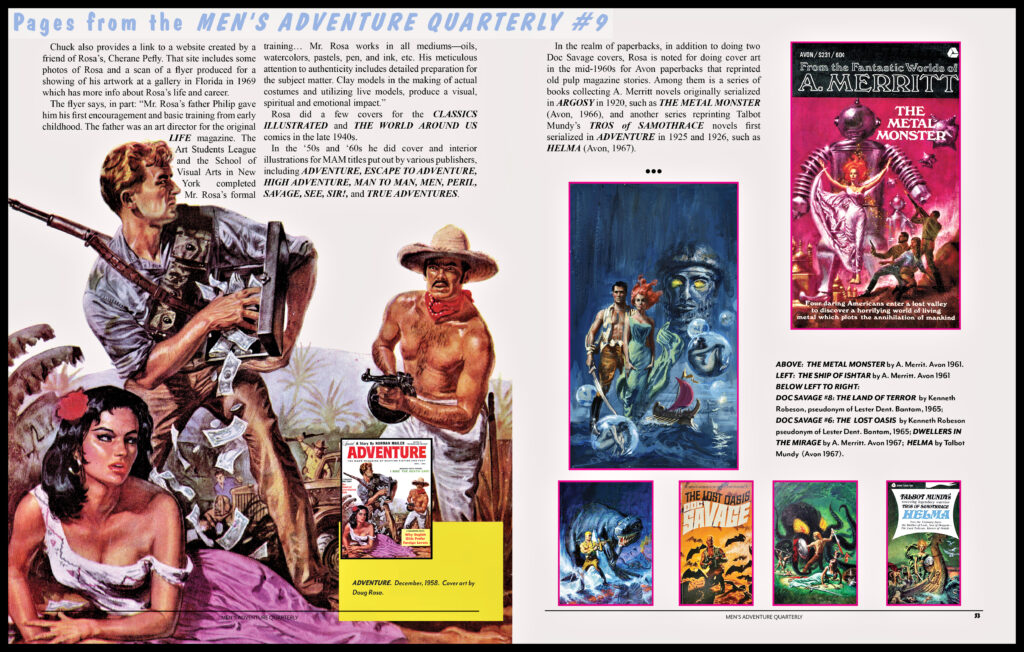
One of the cool articles in MAQ #9 is by my co-editor, Bill Cunningham, head of the Pulp 2.0 Press indie book company. In addition to being a writer and publisher Bill is an amazingly creative graphic designer. His MAQ #9 article “HOW THE SAUSAGE IS MADE” shows how he makes the graphic images from the MAM stories we reprint even cooler by adding spot color, full color and various other design elements. His talent and creativity constantly amaze me. You can see why in the “before and after” examples he shows in his article.
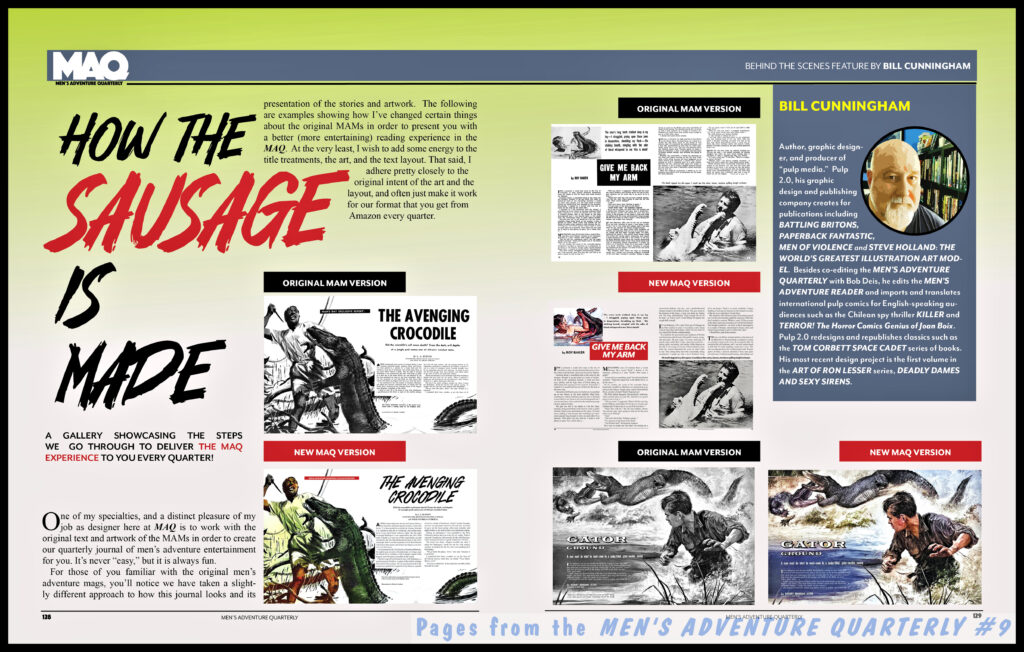
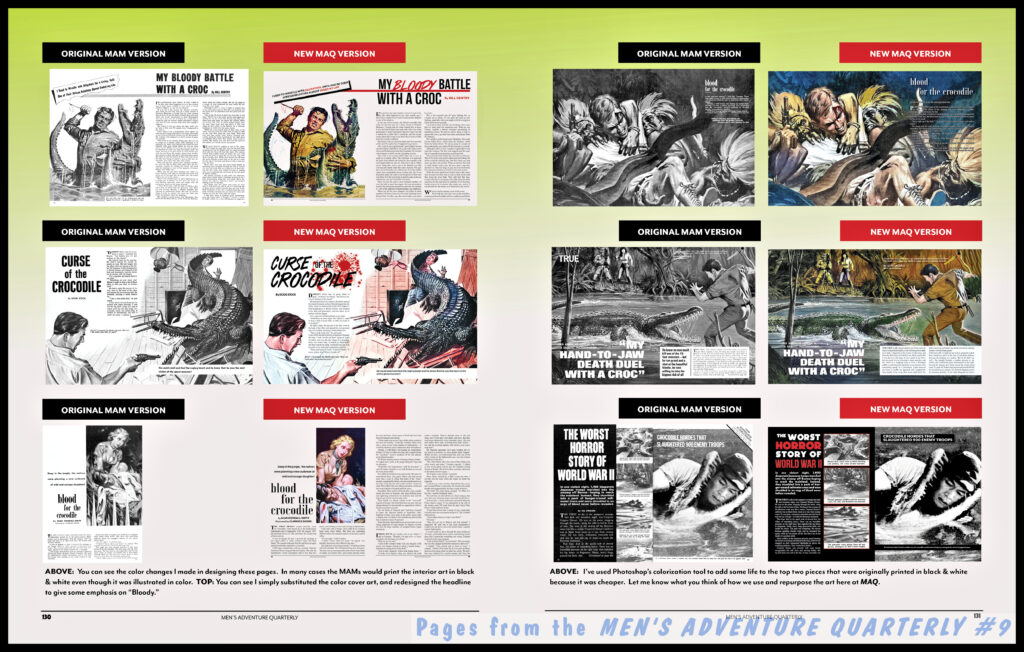
Issue #9 of the MEN’S ADVENTURE QUARTERLY is the first of the four issues Bill Cunningham and I plan to publish during our third year of producing the MAQ. It’s also the second issue we’re publishing in three editions: our traditional full color print edition, a lower priced black-and-white “Noir Edition,” and a full color “Digital Replica Edition.”
We started this new approach when Amazon KDP increased their print-on-demand printing prices, so there would be affordable options for all interested readers. Bill is now working on providing those same options for all previous MAQ issues. By the way, you can get MAQ #9 and all other MEN’S ADVENTURE QUARTERLY issues via Amazon in the US, Amazon UK, Amazon Canada, Amazon Australia, Amazon Germany, and other Amazons worldwide. I also sell the full color print editions, with free shipping, in my bookstore. If you buy a copy directly from me, I’ll sign it and add an inscription if you want.
In my next post, I’ll talk about some of the other stories in the MEN’S ADVENTURE QUARTERLY #9. In the meantime, click this link or the image below to see a cool video preview of MAQ #9 posted by vintage media maven Jules Burt on his popular “Collections and Unboxings” YouTube channel.

